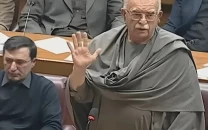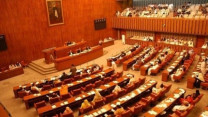With Rs9.5tr outlay, govt to rely on loans
58% of the budget to be spent only on debt servicing and defence

The coalition government may unveil a nearly Rs9.5 trillion budget that has been prepared on a highly ambitious target of a mere 4% increase in expenses but one-fourth surge in revenues aimed at meeting a core condition of the International Monetary Fund.
Sources told The Express Tribune that the federal government has finally agreed to exhibit a primary budget surplus of nearly Rs200 billion by planning fiscal consolidation of nearly Rs1.8 trillion or 2.2% of the Gross Domestic Product in the next fiscal year.
The budgetary framework is projecting about 0.3% of the GDP primary budget surplus – showing that its net income will be more than the expenditure, excluding debt servicing cost. Earlier, during the Doha round of talks, the government had presented a primary budget deficit framework, which the IMF did not agree to.
A major chunk of the new budget – the Rs5.5 trillion or 58% of the budget – will be spent only on two heads – debt servicing and defence. There is an alarming increase of over Rs800 billion or 26% increase in debt servicing cost in just a year. In the outgoing fiscal year, the share of these two components was half of the total budget. The defence services’ share remained constant but the debt servicing has gone out of control.
Although the government will be aiming at close to a Rs200 billion primary budget surplus, the finance ministry will still borrow Rs4.6 trillion to run its operations, thanks to the nearly Rs4 trillion debt servicing cost in the fiscal year 2022-23. This will be the highest-ever debt servicing cost in the history of Pakistan.
The sources added that as against Rs1.6 trillion estimated primary deficit in the outgoing fiscal year, the new budget may be unveiled with a primary surplus target of nearly Rs200 billion. The Rs1.8 trillion or equal to 2.2% of the GDP steeper adjustment will be challenging in an election year and chances of slippages will remain high.
The sources said that a budget of close to Rs9.5 trillion has been prepared on the assumption of less than 4% increase in expenditures over the revised estimates of this year but one-fourth increase in income.
A senior official of the finance ministry agreed that these assumptions were “ambitious” but there was no other option due to the IMF’s demand for showing primary budget balance.
The draft budget figures have been shared with the IMF and a meeting is expected today (Wednesday). The sources said that certain changes can be made in light of the IMF’s observations.
The total size of the federal government expenditure is estimated around Rs9.5 trillion, which is higher by nearly Rs350 billion or 4% over this year’s revised budget of over Rs9 trillion. There was an increase of 11% in expenditures if compared with the original budget of Rs8.5 trillion, which now has become redundant.
The current expenditures are targeted to grow only over 2% to Rs8.6 trillion against the revised estimates, the sources said.
The debt servicing cost that was Rs3.1 trillion in this year will jump close to Rs4 trillion –an increase of Rs800 billion or 26%. The domestic debt servicing will eat up nearly Rs3.5 trillion while another Rs500 billion will be given for foreign debt servicing.
The average interest rate in the next fiscal year is estimated at 14%, which would take away what the government will earn in additional revenues.
The sources said that the defence budget is estimated around Rs1.53 trillion –up by Rs73 billion or 5% over the revised budget of the outgoing fiscal year. The Ministry of Defence has already taken a Rs80 billion supplementary budget last week for the outgoing fiscal year.
The government may drastically cut subsidies that are estimated near Rs650 billion in the next fiscal year. These are down by Rs850 billion or 60% over this year’s revised estimates, the sources said. The cost of pensions is Rs530 billion and the running of the civil government consumes only Rs550 billion, the sources said.
The Ministry of Finance has not indicated more than Rs725 billion for the Public Sector Development Programme for the next fiscal year, although Planning Minister Ahsan Iqbal unveiled the draft PSDP of Rs800 billion.
“We have prepared a very progressive budget that will also ensure fiscal consolidation,” Finance Minister Miftah Ismail said on Tuesday, adding that the overall budget deficit would be less than 5% of the GDP.
The government has pitched the budget deficit target of 4.8% of the total size of the economy, or Rs3.77 trillion, to the IMF for the next fiscal year.
The finance minister said that the government would focus on agriculture, productivity enhancement and exports promotion in the next budget. The government will also revive the privatisation programme.
But the major challenge for the finance minister would be arranging a record $41 billion in foreign loans in the next fiscal year to remain afloat. Pakistan would require repaying $21 billion foreign loans. It will need another $12 billion for current account deficit financing and $8 billion more for increasing foreign exchange reserves to $18 billion, the finance minister said.
He assured that the adequate arrangements had been made for securing these loans, as the IMF programme was expected to become effective from next month.
The sources said the Federal Board of Revenue’s tax target could be set at Rs7 trillion, which is higher by 17% over the revised estimates. The non-tax revenue receipts were projected at Rs2 trillion, which would require 52% growth, indicating that the government would restore petroleum levy rates.
Prime Minister Shehbaz Sharif on Tuesday said that his government would impose taxes on nonproductive sectors, particularly real estate.
The gross revenue receipts are estimated at Rs9 trillion for next fiscal year – up by nearly one-fourth or Rs1.7 trillion. The provinces will get Rs4.1 trillion as their share, leaving the federal government with Rs4.9 trillion net revenues. The net income of the federal government is expected to be Rs600 billion less than the expenditure on defence and debt servicing, the sources said.
Although the overall budget deficit is projected at Rs3.8 trillion due to an anticipated Rs800 billion provincial cash surpluses, the federal government will still have a Rs4.5 trillion deficit, equal to 48% of the total size of the budget.









1733130350-0/Untitled-design-(76)1733130350-0-208x130.webp)









COMMENTS
Comments are moderated and generally will be posted if they are on-topic and not abusive.
For more information, please see our Comments FAQ